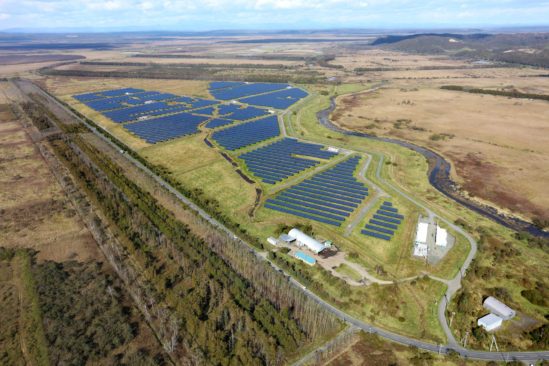
The Toritoushi photovoltaic plant in Japan uses LIM50EN battery modules from GS YUASA to stabilise power fluctuations.
In order to buffer photovoltaic systems and thus sustainably advance the use of renewable energies, GS YUASA promotes the use of high-performance lithium-ion battery systems in power generation.
In Space: Batteries buffer the photovoltaic system of the ISS
The Group’s space lithium-ion batteries are used on the International Space Station (ISS). The ISS is a manned test facility constructed approximately 400 km above the Earth’s surface. It is used through the cooperation of many countries.
Power for all equipment on the ISS including experimentation and observation devices and life support systems is supplied by photovoltaic power generation. However, power generation ceases 16 times each day as the ISS passes through the earth’s shadow, and during these periods, power is supplied by GS Yuasa lithium-ion batteries for space use.
On Earth: Batteries buffer photovoltaic power plant
A photovoltaic generation system using the GS Yuasa Group’s lithium-ion batteries has been in operation at the Kushiro Town Toritoushi Wildland Photovoltaic Generation Plant in Hokkaido.
When generating photovoltaic power, changes in natural conditions, such as sunshine hours and temperature, can lead to significant fluctuations in the power generated, while a major increase in the photovoltaic power load could reduce the quality of the system’s power in terms of both voltage and frequency. For this reason, storage battery systems are necessary to stabilize output fluctuations in power generated when photovoltaic power generating facilities are connected to the power grid.
LIM50EL batteries from GS YUASA
The industrial lithium-ion battery modules of the LIM50EL series from GS YUASA (Successor model to the LIM50EN, which is used in Toritoushi, among other places), enable use over long periods of time in applications with frequent charge/discharge cycles as well as in environments with relatively high temperatures.
They thus offer a safe backup solution for data centres. Their cyclic lifetime is 11,000 charge/discharge cycles (at DOD 100%). The lifetime at float charge is 15 years, after which the batteries still have a residual capacity of at least 90%. They have a nominal capacity of 48.5Ah (0.2C), a maximum charge current of 125A (2.5C) and discharge current of 300A (6C). The operating temperature range is -20 to +45°C. In addition, the LIM50EL modules are equipped with external communication functions compatible with monitoring systems for GS YUASA storage batteries.

The high-performance LIM50EL lithium-ion battery modules from GS YUASA with 11,000 charge/discharge cycles are suitable for applications with frequent charge/discharge cycles.
or register here for the new YUASA newsletter: Register to the newsletter
GS YUASA Battery Germany GmbH, founded in 1983 as YUASA Battery (Europe) GmbH, is based in Krefeld and serves 15 countries within Europe from there.



